Hojicha latte, Hojicha flavoured ice cream, Chiffon cake and even KitKats in Japan are flavoured with Hojicha. I am so happy to see more and more Hojicha drinks and sweets outside of Japan. So, if Japanese green tea or Matcha is not usually your cup of tea, you might just find that Hojicha is!
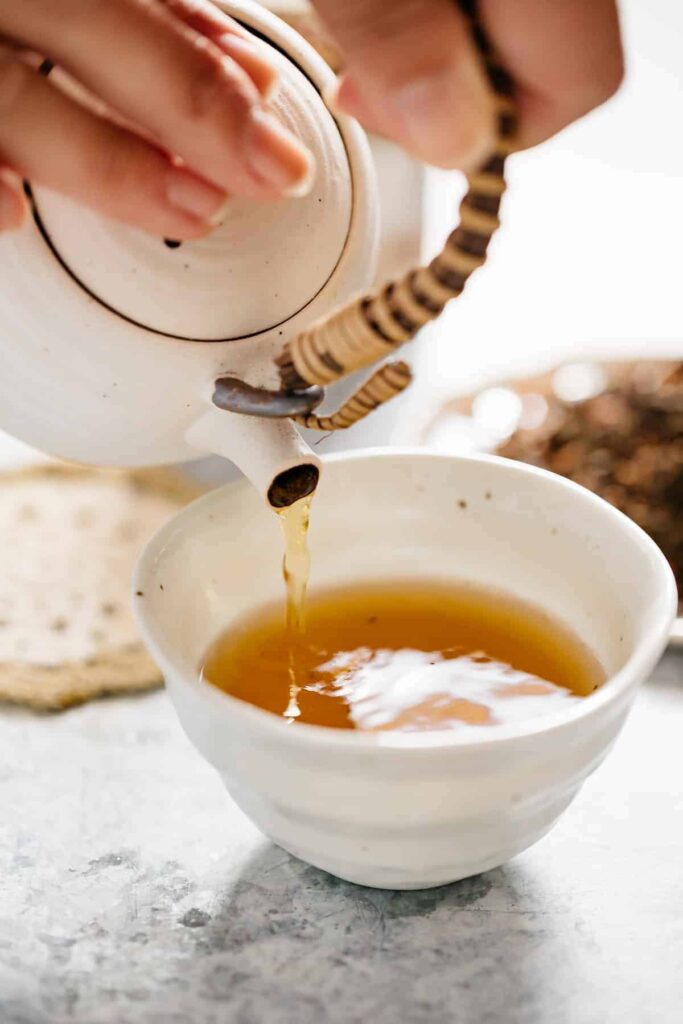
What is Hojicha
Hojicha is a green tea which is roasted at about 392°F (200°C) until its leaf colour alters to a reddish-brown and becomes aromatic. It is a less astringent tasting tea because in the roasting process the amount of caffeine and tannin is reduced. Hojicha is a tea that has a smooth and mellow fragrance and taste.

The Benefit of Drinking It
It is said that “Green tea is about taste and Hojicha is about aroma.” You will enjoy the scent of Hojicha when you are tired because it has a relaxing effect. It is the theanine in the green tea that has this effect. Although the theanine content in Hojicha is only about one-hundredth of the amount in normal green tea, it has the same relaxation effect as when drinking green tea itself. The secret is not the components of the tea, but rather the many different combinations of Hojicha fragrances.
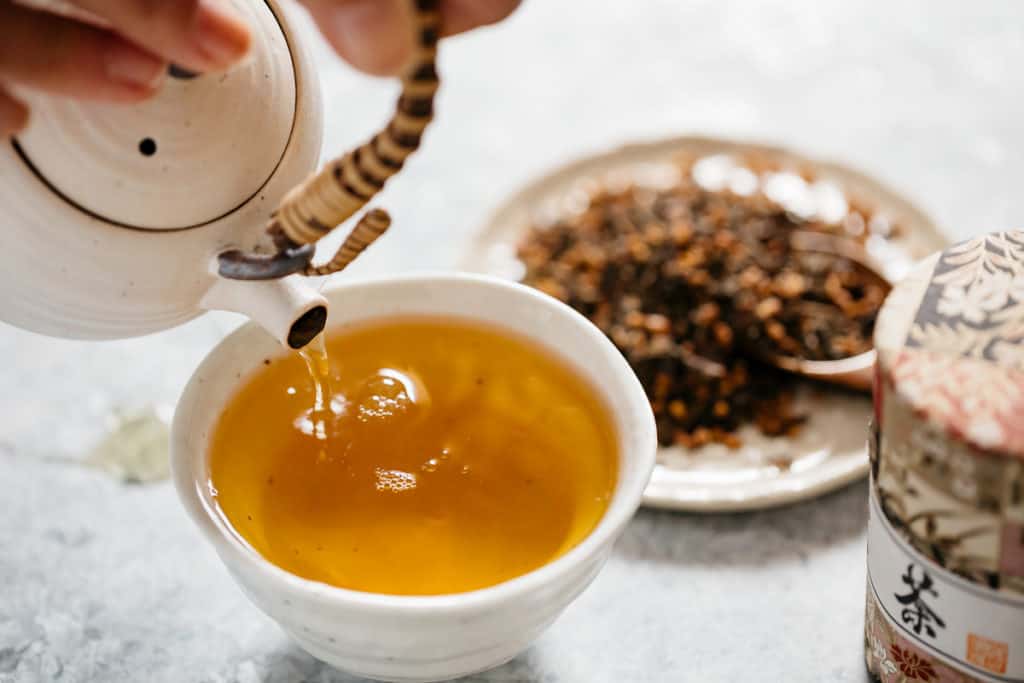
Homemade Hojicha
Ok, so those who have never heard about Hojicha and don’t know where to get it from, I have great news for you. You can make it. “Hoji” means roast in English. As I have mentioned above, Hojicha is roasted Japanese green tea, usually either “Sencha” or “Ban Cha
“. So if you have green tea sitting in your pantry and you have not used much, you can roast it to turn it into freshly roasted Hojicha.

3 Ways to Roast Japanese Green Tea
You can either use a steel frying pan, a clay pot or oven to roast Japanese green tea. Probably the most convenient method is using a steel frying pan though be careful not to use a non-stick frying pan. You will need a steel frying pan, a lid for the frying pan, a wet kitchen cloth, wooden spatula or chopsticks, cooling tray with parchment paper-lined, and a tea caddy to keep them.

Roasting with a Steel Frying Pan
- Preheat the frying pan for 30-second Heat the frying pan over high heat for about 30 seconds then turn the heat off.
- Leave the frying pan over a wet kitchen cloth for 2 seconds In order to achieve even heat distribution of the frying pan, leave the frying pan on a wet kitchen cloth for just 2 seconds.
- Scoop 2-3 tablespoons into the frying pan
- Put the lid on and leave it for 2.5 minutes Draw out the fragrance of the Japanese green tea thoroughly. Do not open the lid for 2.5 minutes.
- Heat the frying pan for 1 minute over high heat to roast the green tea leaves Be careful not to burn… once smoke comes out, turn the heat off and keep roasting with the residual heat
- Cool it completely then transfer to the tea caddy
Using a clay pot – Same as using a steel frying pan, you need to preheat the clay pot. However, check your clay pot “how to use instructions”. Mine said do not cook without anything in it. So I had to add the green tea leaves from the beginning but ideally preheat. Add tea leaves in and roast over low heat until it becomes aromatic. Turn the heat up and toast it for 1 minute. Turn the heat off and toast further 1 minute with the residual heat.

3 Essential Utensils to Brew Hojicha
Teapot (kyusu)
There are many different types of teapots in terms of materials, size, shape, handle and sieve. Japanese tea brewing time differs according to the different types of Japanese tea. It is important to choose the right teapot in order to brew delightful tea. For Hojicha, an earthenware teapot is best suited because of its heat retention.
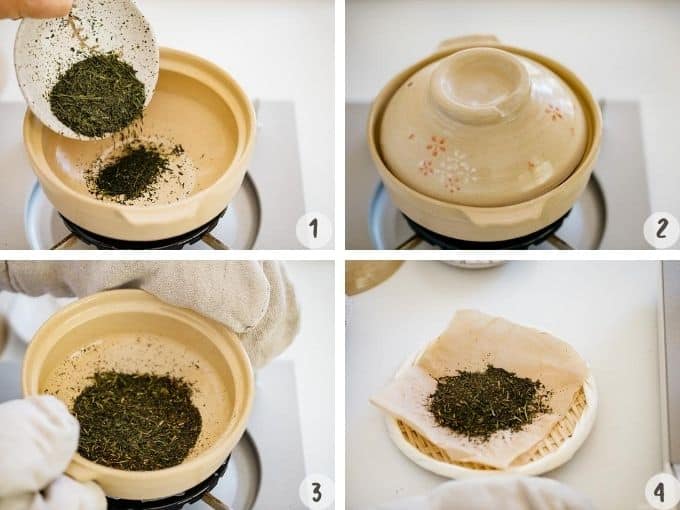
Tea cups (yunomi chawan)
Same for the cups too. Because brewing Hojicha requires above 95C (203F) hot water to be poured in and brewed for 30 seconds, earthenware teacups are the best to retain its heat. There are many types and usually taller cups are used for Hojicha.
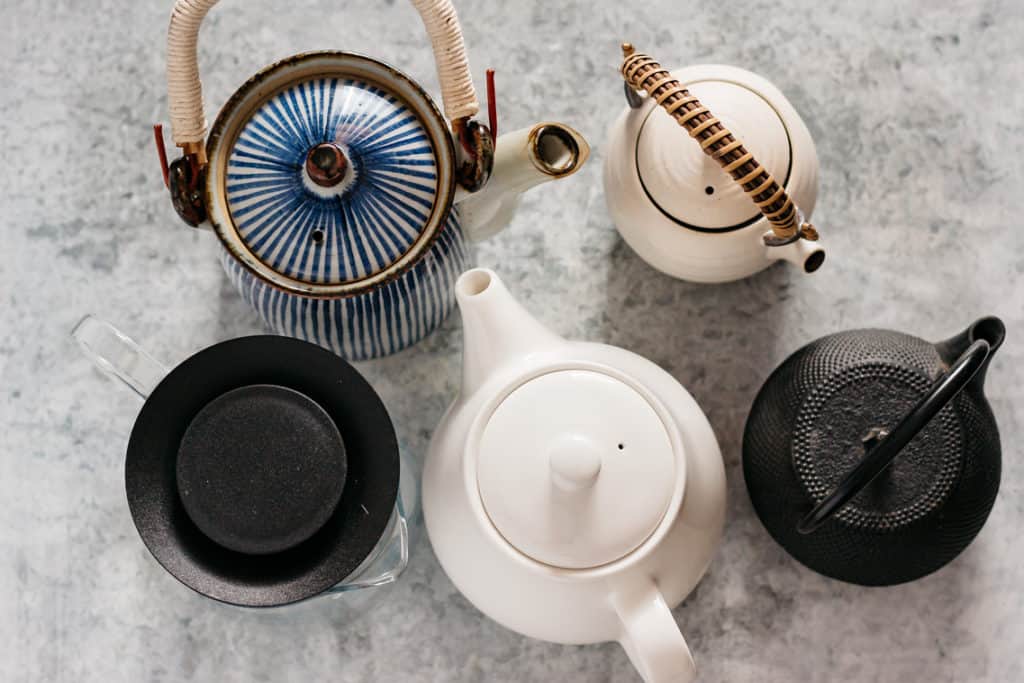
Tea caddy (Chazutsu)
Tea leaves are susceptible to temperature, humidity, air and light. So it is important to store the leaves in an airtight container. Tea caddies are called Chazutsu in Japanese and are typically made out of metal. I bought mine in Kyoto. They are metal with an inner lid to ensure airtightness and an outer lid. The outside is decorated with beautiful Japanese washi paper.

Hot Brew For One
- Tea leaves dose: 1 tsp (2g)
- Hot water: 2/3 cup (160ml)
- Water Temperature: 203-212°F (95-100°C)
- Steeping time: 30 seconds
The key is in the temperature of the water and steeping time. In general, very hot 203°F (95°C) water is used for brewing Hojicha in order to enjoy its fragrance. Hojicha leaves have less Umami and astringent components. It will not be extracted strongly even when brewed at high temperature. Pour hot water directly into the pot and leave for 30 seconds. Pour the tea into teacups evenly. Do not pour to fill one cup at a time, but rather pour a little amount to circulate the cups. Also, tap out all the tea ensuring no water is left in the teapot.
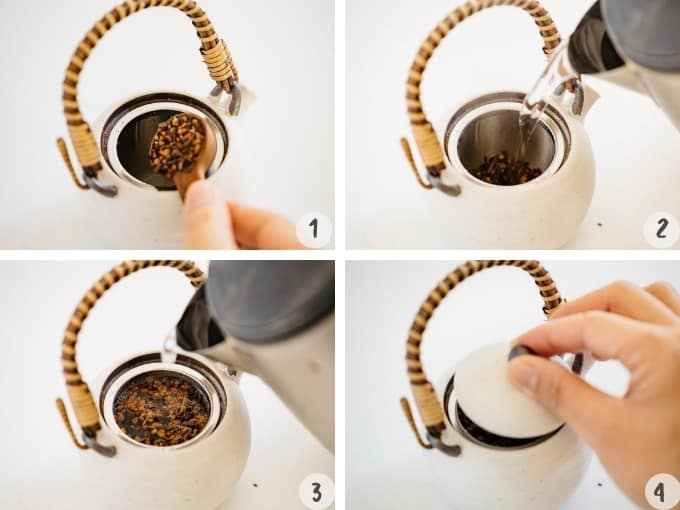
Cold Brew
To make cold brew Hojicha, I usually brew hot and then cool it down to room temperature, and then keep it refrigerated. So brew about 1 tbsp of tea leaves with 2 cups (500ml) of boiling hot water. Cool it down and chill it in the fridge.
How to store Hojicha tea leaves
Remember Japanese tea leaves are sensitive to humidity, oxygen, light and high temperature. If the package is not opened, you can store it in the fridge, but once the package is opened, it needs to be stored in a dark and cool place in an airtight container.

Culinary Use of Hojicha
Hojicha is often used in cooking and baking too just like Matcha is used in Japanese cooking. I have shared my Hojicha Chiffon cake recipe, Hojicha pudding, Hojicha latte, Hojicha muffin, the possibilities are endless.

Japanese Sweets to Serve Your Tea With:
- Kasutera(Castella)
- Daifuku Mochi
- Strawberry Daifuku
- Dorayaki
- Mitarashi Dango
- Three Coloured Dango
- Sakura Mochi
- Yomogi Mochi
- RainDrop Cake
- Taiyaki
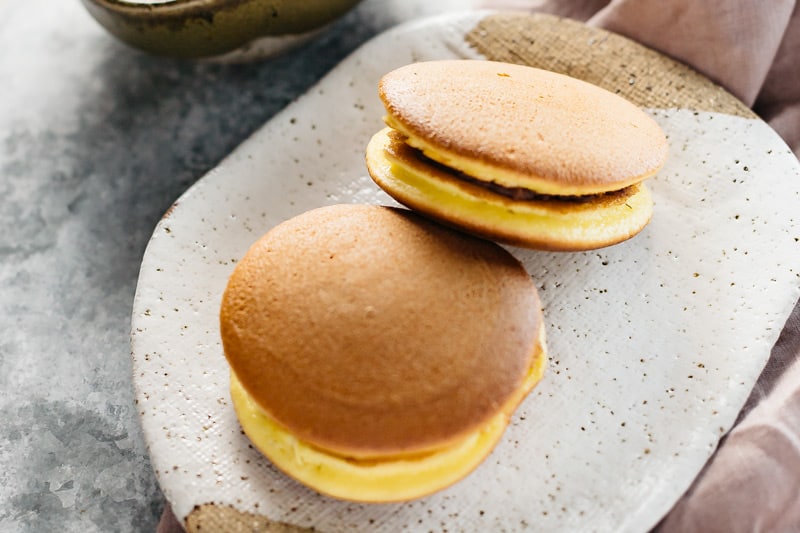
FAQ
A: Yes Hojicha does contain caffeine however only a small amount. Hojicha contains 1/3 the caffeine of Matcha, and 1/2 of English black tea. The same amount of caffeine will be lost in the process of making the Hojicha.
A: The roasting process makes this tea naturally less astringent and bitter. It has an earthy and nutty mellow flavour and so it is easy to drink at any mealtime. It also suits any type of cuisine. And because it has less caffeine it is suitable for children to drink and at any time even before bedtime.
Stay Connected
Here is my instruction for brewing delightful Hojicha and If you liked it, please rate it and leave a comment below. Also, don’t forget to follow me on Youtube, Pinterest, Facebook , Twitter and Instagram to keep up to date with all the latest happenings on Chopstick Chronicles. Don’t forget to use the hashtag #ChopstickChronicles so I can see your wonderful creations!
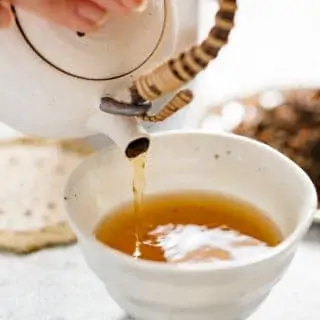
How to brew Hojicha
Ingredients
- 1 tbsp Hojicha tea leaves *6g
- 16 fl oz/480ml Hot water over 302°F/95°C *2 cups *1
Instructions
- Place hojicha leaves in a tea pot.
- Boil water and pour very hot water (over 203°F/95°C) into the teapot.
- Place the teapot lid on and leave it for 30 seconds to let the tea leaves open.
- Pour the tea into three tea cups. Pour a small amount at a time and circulate from cup to cup to ensure same consistency of tea in each cup.
- Tap out all the tea to three cups.
- Enjoy!
Notes
Nutrition
Chopstick Chronicles is a participant in the Amazon Services LLC Associates Program, an affiliate advertising program designed to provide a means for sites to earn advertising fees by advertising and linking to Amazon.com. As an amazon associate I earn from qualifying purchases.
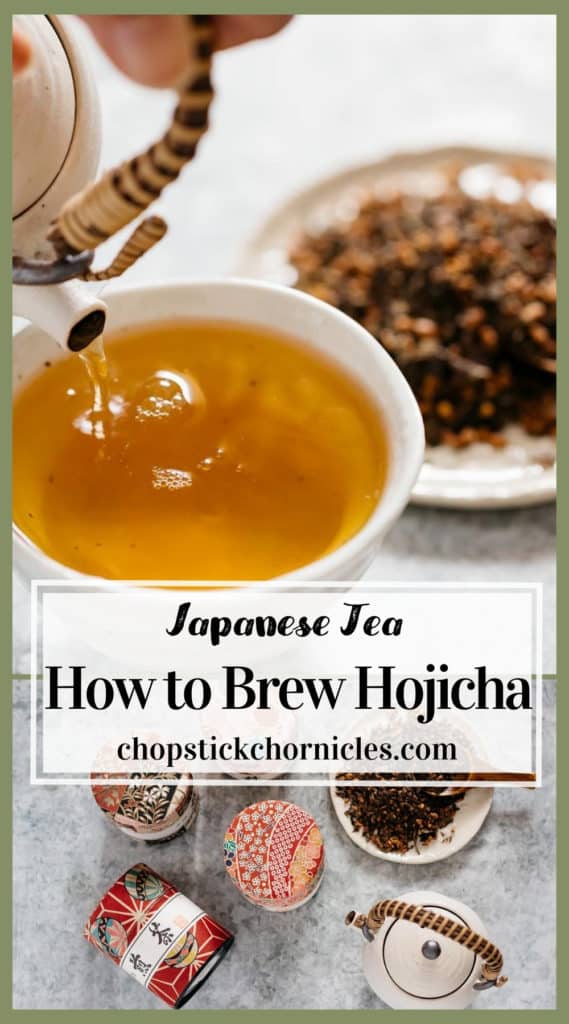
Hi Shihoko, I want to try making hojicha soon, but I’ve been wondering about one thing that you mentioned in the description. You said we shouldn’t use a non-stick frying pan. Why? Where would be the difference if I roasted green tea leaves with a non-stick pan? .. because I don’t have a steel pan :/
Hi Mandy, when non stick frying pan is heated, it release chemicals which are not good for your health.
thank you for this! I love hojicha and I followed your recipe and it turned out so good and it had such a delicious roasted tea smell
You are welcome Libby 😀 Hojicha is my favourite too.
Thank you for your clear instructions on making hojicha tea. The other uses of the tea sound delicious! I love the beautiful tea pots and cups. I cant wait to sip my first pot of tea. xx
Thank you Tara. I am sure you will like this tea 😀
Hi Shihoko! Love your blog! I just stumbled across your hojicha instructions and was wondering if you had tips for cold hojicha? Would you recommend cold brew, or hot brew then put into the fridge? Thank you!
Hi Samantha, there are some brand selling you can cold brew, but if the package does not state it I would hot brew then put it in the fridge 😀
Is this good for hair regrowth?
I tried it anyway, and it’s a very relaxing green tea.
Hi Clayton, well it does contain antioxidant so it may be good for your hair regrowth, finger crossed.
Hello! Thank you for all the wonderful recipes. I was wondering if you could help me know where to buy the beautiful tea cups and pot you have.
Hi Amber, I bought those tea pot and cups when I went back to Japan while ago. They still had same pot and cups when I visited in April this year. They are from a pottery shop in Ise city. Where do you live? in Australia or US?